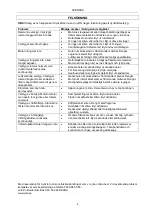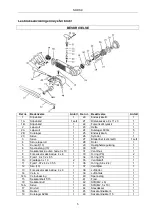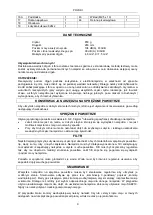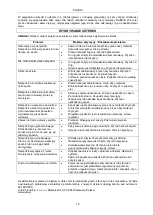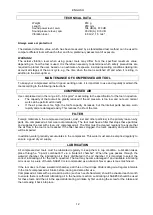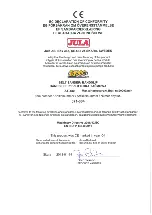
ENGLISH
12
TECHNICAL DATA
Weight
850 g
Length
280 mm
Sound power level, LwA
Sound pressure level, LpA
Vibration level
104 dB(A), K=3 dB
93 dB (A), K=3 dB
4.8 m/s², 1.5 m/s²
Always wear ear protection!
The declared vibration value, which has been measured by a standardised test method, can be used to
compare different tools with each other and for a preliminary assessment of exposure.
WARNING!
The actual vibration level when using power tools may differ from the specified maximum value,
depending on how the tool is used. It is therefore necessary to determine which safety precautions are
required to protect the user, based on an estimate of exposure in actual operating conditions (taking into
account all stages of the work cycle, e.g. the time when the tool is switched off and when it is idling, in
addition to the start-up time).
MAINTENANCE OF COMPRESSED AIR TOOL
To keep your compressed air tool in good working order, it is important to use and regularly maintain the
tool according to the following instructions.
COMPRESSED AIR
Use compressed air in the range 6.0
– 8.0 kg/cm
2
or according to the specification for the tool in question.
The capacity of the tool will be greatly reduced if the air pressure is too low and not even normal
work can be performed correctly.
If the air pressure is too high, the tool's capacity increases, but the internal parts become worn
rapidly and are damaged easily. This reduces the life of the tool.
FILTER
Foreign materials in the compressed air (water, dust, rust and other particles) is the primary reason why
parts of a compressed air tool wear out prematurely. The tool must have a filter that stops these particles
and supplies the tool with clean, dry compressed air. The filter must be cleaned regularly to ensure that
the air flow in the tool is not reduced. If the filter becomes clogged, the tool's capacity and performance
will be impaired.
In addition, water gradually accumulates in the compressor. This water must also be emptied regularly to
ensure a good, dry air supply.
LUBRICATION
All compressed air tools must be lubricated regularly to keep them in top condition. Lubrication takes
place through a "3-point combination" via a "water/oil chamber". When the gas passes through the
water/oil chamber, the lubricating oil is finely distributed in the oil chamber. It is important to select the
correct lubricating oil for the tool in question. The tool may become damaged if an unsuitable lubricating
oil is used. As a rule of thumb, SAE#10 is recommended as a lubricant. Never use viscous machine oil.
If the tool does not have a water/oil chamber, add three or four drops of lubricating oil at regular intervals
in the tool's compressed air intake before, during and also after use.
Compressed air tools with a percussion action (such as needle hammers) should be checked each month
to ensure there is sufficient lubricating oil in the hammer section. Lubricating oil SAE#30 should be used
for these tools. Add the oil in the special lubricating oil intake by first undoing the screw for the intake and
then screwing it back into place.
Summary of Contents for 071-004
Page 14: ......




